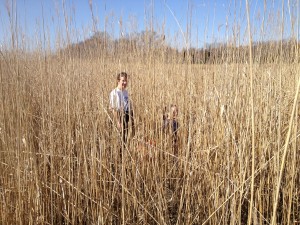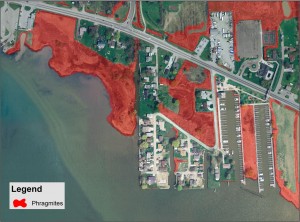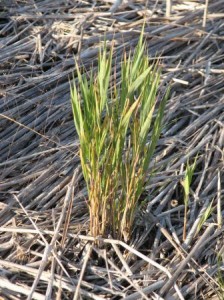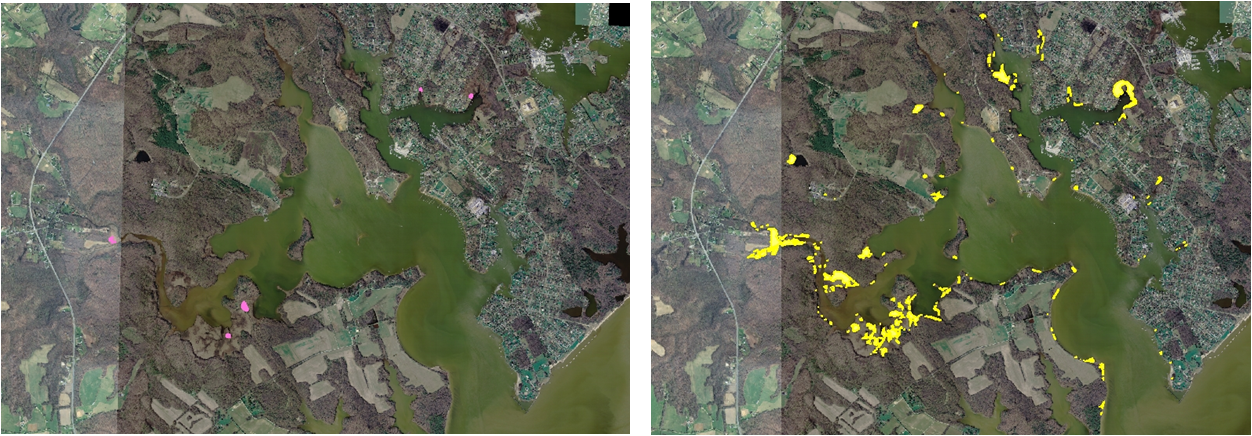Monitoring
Monitoring is a critical step in the invasive plant management cycle. Monitoring data aids in determining the effectiveness of previous management activities and informs future management actions.
Management sites should be frequently visited for monitoring native plant recovery and early detection of Phragmites seedlings or missed stands. Rapid response to isolated stands can considerably reduce the costs of management efforts. Moreover, it is important to control seedlings before they start to reproduce sexually and further contribute to the seed bank. Long-term monitoring should also take into account potential surrounding sources of Phragmites seeds or fragments. Identifying adjacent populations of Phragmites and potential vectors of Phragmites (e.g. roads, rivers) is an effective way to evaluate the risks of re-introduction. Prevention is often the most cost-effective way to manage invasive species. It is crucial continually monitor sites and to limit the growth of Phragmites stands around managed habitat to prevent the establishment of new colonies.
A standardized monitoring protocol has been developed for use in the Phragmites Adaptive Management Framework (PAMF) – to learn more, click here or email phragmites@glc.org.
Monitoring techniques
Monitoring programs are an important, but often overlooked, part of non-native Phragmites management and control. Monitoring for early detection and then responding rapidly with proper management techniques can help reduce new non-native Phragmites invasions. In areas where non-native Phragmites is already established, monitoring plans should be in place to assess habitat response after management actions to help quantify the outcome of management efforts and provide insight for modifications to the management protocol.
To be effective, a detailed, site-specific, and achievable monitoring plan should be created prior to any management. In order to determine the effectiveness of management efforts, it is important to collect data in a structured way both before and after treatment. Collected data should be reviewed and analyzed to identify opportunities for modifying future management actions. This iterative approach to monitoring, analysis, and management will lead to the increased long-term effectiveness of management. Monitoring plans do not need to be overly complicated, and can be scaled to meet the skills and capacity of the manager. In some cases, pre- and post-management monitoring may be accomplished most efficiently by partnering with another organization, such as a federal or state agency, university, or local interest group.

Photo points
Taking pictures of a fixed location through time allows you to visually track changes at that location. Photo points should be recorded with GPS coordinates and the compass direction of the photograph. Physical markers such as T-posts driven into the ground can aid in finding the exact location from which to take the photo.
- Pros: quick, inexpensive, visual
- Cons: quantitative measurements (e.g., species diversity, stem density) are lacking

Aerial photos
Pros: quantitative measurements.If you have aerial photos taken of the same area through time, you can track the extent of Phragmites either by hand or with geographic information system software such as ArcGIS or Quantum GIS.
Cons: often expensive, requires software and trained staff.
Aerial photo of Rhode River, MD, from 1970 (left) and 2009 (right). Photo credit: Dr. Dennis Whigham
Resources:
- Maheu-Giroux, M. and S. de Blois. 2005. Mapping the invasive species Phragmites australis in linear wetland corridors. Aquatic Botany, 83 (4): 310-320. Abstract (Visit the Phragmites Research Group webpage to request a reprint)
- Pengra, B. W., C. A. Johnston and T. R. Loveland. 2007. Mapping an invasive plant, Phragmites australis, in coastal wetlands using the EO-1 Hyperion hyperspectral sensor. Remote Sensing of Environment, 108(1): 74-81. Abstract

Field methods
Obtaining more quantitative data on species diversity, stem densities, water levels, etc. requires direct measurement. Type and frequency of data collection will depend on site characteristics and clearly articulated project objectives. Measuring plant species presence and dominance in quadrats (e.g. 1 m square) or along transects are common field methods. Field monitoring can also provide insight into non-native Phragmites management efficacy and follow-up needs. Even when the majority of a non-native Phragmites stand has been effectively killed with herbicide or other management techniques, it is likely that Phragmites seeds remain in the seedbank or some portion of the rhizome remains viable. Monitoring can include information about stand mortality, new Phragmites seedlings, or other observances such as “witches broom” regrowth, which can occur if there has not been a complete kill belowground. The “witches broom” growth form is one where many small stems grow from a single node that may be buried or exposed.
- Pros: more detailed data that can be tested with statistical tools. Comparable among years and projects.
- Cons: time intensive, requires training.


